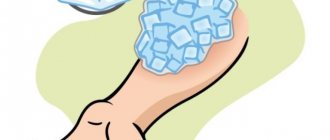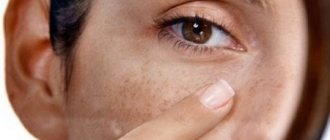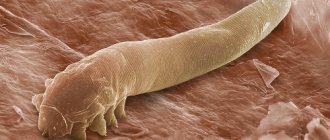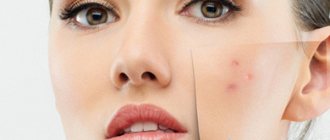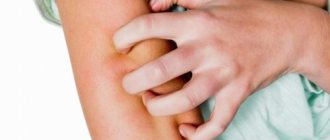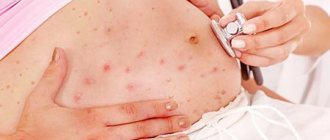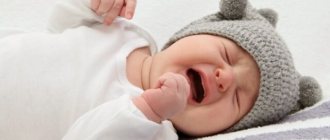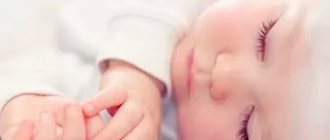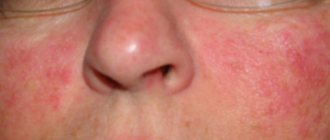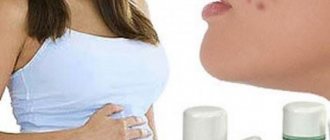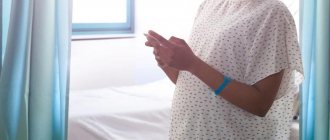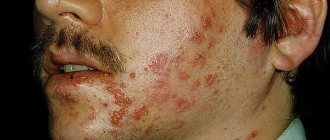After birth, the baby may develop pimples on the face and body. They can cover the entire body or accumulate in certain places. Moms are worried about this situation. In order not to panic, you need to understand the nature of the rashes and the reason for their appearance. Pimples on the face of a 1-2 month old newborn with a white head are not dangerous and are the cause of malfunction of the sebaceous glands.
Reasons for appearance
To properly care for your baby, it is necessary to identify why pimples appear on the face. They can be of different types, colors and shapes. The most common are red pimples with white heads.
Doctors do not have a consensus on where pimples come from. The most common reasons are two:
- Hormonal adjustment of the body.
- The period of adaptation to the new environment.
The female sex hormone estrogen, which is produced in the mother's body, is passed on to the child. This hormone passes from mother to baby during pregnancy and childbirth. It makes the sebaceous glands actively work. They, in turn, intensively produce subcutaneous fat, which clogs the pores on the face. This leads to inflammation and the appearance of pimples. Mother's hormones do not affect the baby for long. After a couple of months, the newborn’s hormonal levels will stabilize.
The second option is to adapt the child’s skin. In the womb, the child is in water for 9 months. His skin is accustomed to certain conditions. After birth, the skin begins to come into contact with air. This requires a certain restructuring in the functioning of the sebaceous glands. They function in an enhanced mode, which leads to their blockage and the formation of pustules.
Subcutaneous fat serves as a protective barrier for the skin from the aggressive effects of external factors. Therefore, the active work of the sebaceous glands indicates that the body has turned on its protective functions. This has nothing to do with the hygienic care of the baby. And it does not mean that you are not taking good care of the baby.
Neonatal vesiculopustulosis (periporitis)
This is a purulent inflammation of the sweat glands, caused by staphylococci, streptococci, and less commonly fungi. Vesiculopustulosis is a common skin disease among newborns. Appears due to improper hygienic care of the baby’s skin, infections of the mother, as well as a low level of sanitary and hygienic condition in maternity hospitals.
Provoking factors:
- artificial feeding;
- premature baby;
- increased sweating as a result of overheating of the child;
- hypothermia.
Pimples reach the size of a pea and can become inflamed. They no longer appear on the face, but in the hair of the head, less often on the body. For treatment, doctors prescribe treatment of rashes with brilliant green and antibacterial ointments. Recovery occurs after 1.5 weeks.
Newborn acne
The presence of pimples on the face of a baby with a white head occurs in 20-30% of children. The rashes are localized on the cheeks, forehead, nose and chin. Pimples on the face of newborns are similar to teenage acne. They are more likely to affect boys and children whose parents have suffered from acne. Most often comedones do not form, but in rare cases there are closed or open comedones. Pustules, purulent pimples with a white head, form only with acne. Allergic, infectious diseases or prickly heat occur without the appearance of pustules.
Such rashes do not bother children and do not cause itching. Mothers are advised to keep their baby's skin dry and clean to speed up the healing of the skin.
Neonatal acne
With neonatal acne or neonatal pustulosis, the rash appears as subtle pimples that appear on the forehead or cheeks of the baby. These pimples are not visible on the skin itself, but can only be felt with your fingers under it.
Why did they appear? The reason is the same hormonal level in the body. Sometimes these rashes accompany the first month of colonization of the skin by family microflora, among the microorganisms of which there are yeast fungi - they cause acne.
Is it dangerous?
In most cases, this phenomenon goes away on its own within 2-4 months of life.
You should be wary if the rash becomes large and does not go away, continuing after the child is 3 months old and up to one and a half years old. Then there is a possibility that this is infant acne, a disease that occurs due to increased levels of the androgen hormone. It requires treatment exclusively from specialists.
Milia
Another type of pimples on the face of newborns 1-2 months old with a white head is milia. They arise as a result of blockage of the sebaceous glands. The peculiarity of milia is that they cannot be opened, wiped with a cotton pad, or used with alcohol lotions. Because this can lead to the spread of infection.
The cause of milia comes down to the accumulation of hormones in the child’s body, which he received during pregnancy and through breast milk. It takes time for the baby to remove hormones from the body. And the sebaceous glands cannot cope with the accumulated subcutaneous fat that has accumulated in the pores due to hormonal processes.
“Milium” translated from Latin means sifted grain. This type of acne is typical only for newborns. Pimples always have a white tip. Rashes are rare or widespread on the face. The main distinguishing feature of milia is its grain. Places of appearance on the face: forehead, cheeks, area under the eyes. Less commonly, the rash is localized in the neck and chest.
This rash does not cause discomfort to a newborn. The main thing is that the baby does not scratch the pimples.
Rash on the face of a baby: what can cause it
Rashes can be caused by a number of different reasons, ranging from common allergies to infectious diseases. Therefore, each case requires an individual approach and a specific treatment regimen. It is necessary to start therapy only after a preliminary examination and consultation with a pediatrician or dermatologist. Otherwise, the situation can only get worse and lead to unpredictable consequences.
Consider what can cause rashes on the face and body in children.
Acne, hormonal rash, milia or bloom - the appearance on the facial skin of pustules (small formations up to 5 mm in size, inside which there is a viscous yellowish or white liquid) in a newborn at the age of one month. Subsequently, such pimples can merge and even move to other parts of the body (head, neck, shoulders).
Pustulosis is accompanied by the following symptoms:
- reddish pimples with purulent contents or a small red rash appear on the skin of the face;
- they do not bother the baby because they do not cause pain or itching.
Treatment of pustulosis in a newborn is not required, since in most cases the pimples go away on their own within 1-2 months (as soon as maternal hormones leave the child’s body).
Under no circumstances should you treat them with cream, ointment, or alcohol-containing solution, as they will not help get rid of them and will only harm the baby’s sensitive skin. Also, a mother’s strict diet will not help if the baby is breastfed.
We invite you to find out which cream is the best for acne on the face.
It is strictly forbidden to squeeze pimples, otherwise pathogenic bacteria may penetrate under the skin.
Sweating
This pathology occurs as a result of a malfunction of the sweat glands. At the same time, secondary infections can join irritated areas of the skin, causing the appearance of blisters and pustules.
The causes of prickly heat are the following factors:
- heat indoors or outdoors (high temperatures contribute to excessive sweat production, which in turn has an irritating effect on the baby’s skin);
- clothing that does not correspond to the air temperature (some parents, fearing that the baby will catch a cold, begin to wrap him in several diapers and put on a lot of clothes);
- blockage of the excretory ducts of the sweat glands;
- applying various oils to the skin, excessive use of children's cosmetics;
- insufficient care (rare bathing of the baby);
- disturbance of metabolic processes in the body.
Pathology often occurs in premature babies.
Miliaria in a child is characterized by symptoms such as:
- the appearance on the skin, mainly on the neck, chin, back of the head, back, buttocks, groin, of small reddish pimples.
- peeling of the skin may occur;
- the child is bothered by itching.
This condition requires treatment. If heat rash is not treated, there is a high risk of skin infection by fungi or microbes.
The recommended treatment is:
- create comfortable conditions for the baby (optimal room temperature 22 degrees, minimum clothing on the body indoors, dress according to the weather).
- wipe the affected area 3-4 times a day with herbal decoctions (chamomile, St. John's wort);
- provide air baths to dry the skin and rashes (2-3 times a day for 15-20 minutes);
- lubricate the affected areas with a thin layer of zinc ointment (up to 3 times a day).
A food allergy in a baby is a natural reaction of the immune system in response to a particular product in the mother’s diet (during breastfeeding) or to formula milk. It can also occur with complementary feeding products.
Allergic food rash is characterized by the following symptoms:
- a small pink, scaly rash appears on the skin of the face, localized on the cheeks and forehead;
- the baby is bothered by itching;
- Constipation, loose stools, or intestinal colic may occur.
Treatment of food allergic rash consists of several stages:
- when breastfeeding, exclude allergenic products from the mother’s diet (for example, citrus fruits, red vegetables, fruits, confectionery, honey, dairy products, canned food, spices, smoked meats);
- when artificially feeding, it is recommended to switch the child to another formula;
- stop for a while the introduction of the product that caused the allergic reaction;
- identification of the allergen through a special analysis (carried out after a year);
- To relieve symptoms, a doctor prescribes an antihistamine (Diazolin, Claritin, Suprastin, Zodak, Fenistil).
Contact allergies in infants are caused by exposure to any substances (cosmetics, hygiene products, pollen from flowering plants, pet hair, dust, mold).
Contact allergies are characterized by symptoms such as:
- the appearance of red spots or pimples all over the body;
- peeling, itching.
To treat the rash you need:
- consult a doctor and identify the allergen;
- stop using allergenic cosmetics and hygiene products;
- exclude contact with plants and animals;
- prescribing antihistamines and ointments.
Drug allergies are characterized by the appearance of a small red rash and itching. It is a side effect of the use of drugs (antibiotics, medicinal ointments, creams, syrups, multivitamin complexes).
When you stop using them, their unpleasant symptoms disappear without a trace. In this case, you need to replace the drug with a safe analogue.
It is not recommended to give sweet syrups for fever to small children; it is better to use suppositories.
Allergic urticaria in a child is characterized by the appearance of a small, itchy rash throughout the body, which gradually merges into large serous blisters of varying sizes. Urticaria is a severe form of allergy that can cause a dangerous, life-threatening condition called angioedema. Therefore, if spots similar to a nettle burn appear on the baby’s skin, then you need to seek help from a doctor as soon as possible.
The occurrence of such a reaction is possible with any form of allergy (food, contact, drug).
Rashes on a baby’s face can serve as one of the symptoms of infection (roseola, rubella, measles, chicken pox).
Roseola infantile
A viral disease transmitted by airborne droplets or contact. It is caused by the herpes virus type 6, which penetrates the skin or enters the body through the respiratory tract. The incubation period lasts 5-15 days. The disease is common among children under two years of age.
Characteristic symptoms of roseola
The disease begins with a sharp increase in body temperature to 40 degrees. A runny nose, cough, vomiting, and diarrhea may also occur. After 3 days the temperature returns to normal, but after a few hours small rashes appear.
The rash first appears on the face, abdomen, chest, and after a few hours spreads throughout the body. The submandibular lymph nodes increase in size. The rash lasts up to 4 days, then gradually begins to go away.
There is no specific treatment for infantile roseola. Only antipyretics are used (Paracetamol, Nurofen). In some cases, Acyclovir is prescribed.
We suggest you read How to take Valtrex for herpes?
Rubella
Characteristic symptoms of rubella in a child:
- the appearance of a small rash (up to 4 mm) on the face, scalp, neck, behind the ears, and then throughout the body;
- enlargement of the parotid and occipital lymph nodes;
- increased body temperature;
- redness of the oral mucosa.
Thanks to vaccination, rubella is rare. If infection occurs, then no special treatment is required, as the symptoms go away on their own within 5 days. Only the use of antipyretic and antihistamine drugs is permissible.
After recovery, the body develops strong immunity.
This is a highly contagious viral disease, characterized by the appearance of a maculopapular rash on the skin, conjunctivitis, an increase in body temperature up to 40 degrees, and inflammation of the oral mucosa.
The causative agent of the disease is an RNA virus that is transmitted from a sick child to a healthy one during sneezing or coughing. Measles affects children aged 2-5 years.
Newborns up to 3 months are protected by immunity, passed on to them from their mother, who had previously had it.
Characteristic symptoms:
- rise in body temperature to 40 degrees;
- runny nose, sneezing, dry cough, hoarseness;
- conjunctivitis;
- red spots on the sky;
- the appearance on the 2nd day in the area of the painters on the mucous membrane of the cheeks of small white spots surrounded by a reddish border;
- on the 4th day, a small rash appears on the face, behind the ears, neck, then on the torso, fingers, bends of the legs, arms, prone to merging.
There are no drugs to treat the infection. The child may be prescribed antipyretic, anti-inflammatory, expectorant drugs, and antispasmodics.
Chicken pox
A common and highly contagious viral infection transmitted by airborne droplets. Infection of a child can also occur in utero from a mother who did not have the infection and became infected during pregnancy. The causative agent of chickenpox is Varicella zoster.
Chicken pox progresses differently in children. In most cases, the child tolerates the disease easily, his general condition does not worsen and isolated elements of the rash are observed.
But due to the immaturity of the immune system, some children have a hard time with chickenpox with an increase in body temperature, numerous rashes, severe itching, and deterioration in health.
The disease is also severe in newborns who become infected with the virus in utero.
A characteristic symptom of chickenpox is a blistering rash. First, red spots appear, which after a few hours are filled with clear liquid. After a day, the bubbles darken and wrinkle, then become crusty. After a week, the crusts fall off, leaving no traces.
Along with the appearance of the rash, the child’s general condition worsens, he becomes capricious, refuses to eat, and there is an increase in body temperature to 38 degrees.
Mild chickenpox does not require treatment. The child is prescribed antipyretic and antihistamine drugs. In severe cases, treatment is carried out in a hospital, where drugs that have a detrimental effect on the virus are used.
It is important to prevent your child from scratching the rash, otherwise this can lead to infection or scarring. In this case, it is recommended that children wear special gloves, and older children should cut their nails short.
To treat or not to treat
Having discovered a rash on a child’s face, the mother must be sure that it is milia or acne. This type of rash does not require special treatment. Taking antiallergic medications can only worsen the situation. The use of ointments can also injure delicate baby skin. And provoke severe inflammation.
Hygiene procedures are as follows:
- Keep your facial skin clean. Wipe it with plain water, but do not use large quantities of ointments and other cosmetics.
- Avoid contact of hands with pimples. Do not scratch or rip off the skin. Do not wipe your face with alcohol lotions or herbal infusions.
- Make sure your baby doesn't scratch his face on his own - cut his nails short and wear scratch pads.
- Squeezing milia causes scars that can last a lifetime. Don't let it come to this.
Prevention
You can wipe your skin with chamomile infusion. The baby should be dressed according to weather conditions. Clothes should be made from natural materials. Dry air in the apartment is also undesirable; if necessary, you should use a humidifier.
Be sure to read:
Why do longitudinal convex stripes appear on nails?
Bathing should be regular, and the skin should be wiped daily with wet wipes. It is also important to avoid sweating and overheating your baby.
Recommendations for maternal nutrition are similar to those for diagnosing allergies. The same rules apply to artificial feeding - the formula should be selected by a doctor, taking into account all the characteristics of the baby.
What to do
Pimples on the face of a 1-2 month old newborn with a white head go away on their own after a few weeks, when the child’s body gets stronger. The rash does not require special treatment. However, parents can take some measures to alleviate the child’s condition:
- Create a temperature regime for your baby where he will not sweat. Since excessive sweating promotes increased activity of the sebaceous glands, which leads to the formation of pimples and other rashes. In a newborn, thermoregulation is not formed, and he sweats a lot. Therefore, the temperature in the room should not exceed 20 degrees. And air humidity is not higher than 50-70 percent.
- For bed linen, choose natural fabrics. The baby's head sweats the most during sleep. Therefore, place a diaper under your head, previously ironed with an iron. Change it three times a day.
- You can reduce sweating by dressing your child correctly. Don't wear too much clothing. While at home, you don’t have to wear a cap. When going for a walk, choose a suit according to the weather. If your child sweats a lot after going outside, rinse him with warm water without soap. And put on dry clothes.
- If the acne is covered with a crust, do not peel it off. Lubricate your face with peach or olive oil 20 minutes before swimming. Once softened, the crusts are easier to remove.
- Do not rub your baby with a towel after bathing, just gently pat your baby dry. With strong rubbing, microcracks may appear, into which pathogenic microbes can enter.
- A mother should take care of her mood while breastfeeding. When a nursing woman is very nervous, she produces the hormone cortisone. It reaches the baby along with milk. And affects the formation of acne and pimples.
Hormonal rash in newborns and infants
Acne on the skin of a newborn causes confusion among parents.
The baby is taken care of and looked after. The rash on the face, neck, and chest looks even more strange and frightening. The appearance of skin rashes is not always a sign of improper or insufficient hygiene or illness. Sometimes the reason lies in the action of hormones. We will talk about hormonal rash in more detail in this material.
Acne on the skin of a newborn is not such a rare phenomenon; more than a third of all babies suffer from it. As the name suggests, the rash occurs as a result of hormonal changes.
Normally, it is characteristic of two age categories of children - newborns and adolescents. In the former, acne develops under the influence of maternal sex hormones, in the latter - under the influence of their own sex hormones, the production of which is an indispensable condition for the onset of puberty - the puberty period.
In babies, the rash does not develop immediately, but usually in the third week of independent life in this world, which is why the hormonal rash of newborns is often called the three-week rash. These periods are not mandatory, so do not be surprised if skin rashes appear 7-10 days after birth.
In newborns, hormonal rash is considered a physiological phenomenon. It has nothing to do with skin diseases and poses no danger if you take proper care of the skin and prevent the rash from becoming infected with pathogenic bacteria and fungi.
Hormonal rash in children of other ages (preschool and primary school) is always a reason to visit a doctor, since hormonal changes are not normal for such children.
In the last trimester of pregnancy, a woman experiences increased production of estrogen, a hormone that is needed to ensure normal labor. The hormone enters the child’s body in large quantities through the uteroplacental bloodstream.
After birth, the residual hormonal background of the mother continues to influence the functioning of the baby’s body, in particular causing its sebaceous glands to produce more subcutaneous fat than is required to protect the skin from environmental influences.
These excess subcutaneous sebum causes blockage of the sebaceous gland ducts, which are too narrow and therefore physically unable to remove all the fat out. So, white, yellowish or grayish rashes - pimples - appear on the face, neck, and less often on the baby’s chest and head.
The action of the maternal hormone is not endless, and therefore newborn acne (medical name is neonatal pustulosis) disappears after a few weeks without a trace.
The speed of healing will depend on the individual characteristics of the child - for some, pimples go away in a week, for others - only after 20-30 days.
Hormonal rash is most often localized on the face. Yellowish or whitish pimples - comedones appear on the nose, forehead, and chin. They appear less frequently on the cheeks. Sometimes pimples in a baby are localized on the ears and behind them, as well as on the neck and upper chest.
Pimples look like closed small formations that are not prone to merging and do not have purulent heads. There is no thickening of the skin around the rash, no signs of inflammation or redness.
The local immunity of children is not sufficiently developed, and therefore infection of pimples with pathogenic bacteria is possible. Such a complicated hormonal rash looks inflamed and is often accompanied by suppuration of individual elements.
In newborns, in addition to the rash, hormonal “shocks” are accompanied by swelling of the mammary glands (in both girls and boys), slight swelling of the scrotum in boys and labia in girls.
The skin rashes themselves in babies never hurt, do not itch, and do not create any inconvenience for the child. They worry parents more than the babies themselves.
It is not difficult to distinguish the rash that accompanies an allergy from a physiological rash. To do this, you need to carefully examine the baby and note several differences:
- Location - a hormonal rash is localized on the face and neck, an allergic rash can affect any part of the body. A rash on the cheeks is usually allergic, as is the case on the scalp. The rash on the nose and forehead is usually hormonal.
- Appearance - allergic rashes do not have clear boundaries; individual elements of the rash tend to merge and form wider lesions - spots. The hormonal rash has clear outlines, never merges and is not accompanied by erythema (redness).
- Associated symptoms - an allergic rash causes discomfort - itching, tingling, while a physiological rash does not itch or hurt. Allergies are often accompanied by a runny nose, conjunctivitis, a general deterioration in the baby’s well-being, increased moodiness, problems with sleep and appetite. Hormonal rash does not affect the child’s behavior or well-being in any way.
We suggest you familiarize yourself with what hormones are used for acne on the face.
Parents of infants often confuse hormonal rashes and allergic rashes, especially since both are common in children in the first year of life.
Many infectious diseases, including typical childhood ones - chickenpox, measles, scarlet fever and others, are also accompanied by skin rashes. It is also quite easy to distinguish an infectious rash from a hormonal rash:
- Location - the infectious rash covers fairly large areas of the skin; it can be scattered throughout the body. The exception is herpes simplex, which is localized in the area of the nasolabial triangle, but the herpetic rash has a special characteristic appearance - small blisters with an inflamed edging.
- Appearance - infectious rashes have clear outlines, like acne. But they are never comedones - closed pimples, popularly known as wen. With infections, the rash may be watery, purulent, red dotted, but not whitish or yellow.
- Other symptoms - infections, in addition to the rash, are always accompanied by a clear clinical picture - increased body temperature, respiratory signs - cough, runny nose, changes in the condition of the tonsils, muscle pain, changes in the general condition of the child. Nothing similar is observed with a normal hormonal rash.
Hormonal rash in newborns does not require treatment. It is enough to monitor the condition of your skin and practice proper hygiene. It is very difficult for young mothers to remain inactive, to accept the fact that there is no need to do anything. Therefore, they can make their existence easier by paying attention to hygienic treatments.
A baby with neonatal hormonal rash can be washed once a day with a decoction of chamomile. Baths with a decoction of calendula or string will also be useful.
Squeezing pimples is strictly not recommended, as this will increase the risk of bacterial infection.
A child with a hormonal rash does not need sorbents, nor antihistamines and ointments, and wiping the rash with alcohol and any alcohol-containing compounds and lotions is generally dangerous.
It is important to simply ensure that the skin is clean and sufficiently moisturized. To do this, the room should not be hot - no higher than 21 degrees Celsius, and the relative air humidity should be at the level of 50-70%.
A common mistake parents make when a rash appears is to increase hygiene. Frequent washing with soap dries the skin, and the sebaceous glands begin to produce subcutaneous fat even more intensely, as a result, new elements of the rash appear.
Therefore, if you have a hormonal rash, you should wash and bathe without soap at all, and even more so without bactericidal soaps. Such detergents destroy not only pathogenic but also beneficial bacteria on the surface of the skin, as well as the protective layer of children’s skin, the so-called “lipid mantle.”
Parents of babies should consult a doctor if the rash becomes inflamed, the pimples become purulent and the baby’s behavior changes - he begins to eat worse, sleep restlessly, and is capricious a lot.
In other cases, acne caused by hormones is not a cause for concern or parental concern.
Dr. Komarovsky will tell you all about the causes of rashes in newborns in the next video.
Komarovsky about rashes in children
The doctor claims that treating a child’s rash does not require emergency measures. First you need to wait and consult a doctor. It is necessary to distinguish which rash poses a real threat to a person’s life and urgently need to seek medical help. When rashes of an unknown type appear on the skin and mucous membrane and the skin changes appearance and color - this phenomenon is called a rash.
The doctor says that you first need to identify the causes of the rash. The two most important reasons are allergies and infections. Vaccination will help protect your child from diseases that cause rashes, such as childhood measles and . against chickenpox in children , but developments are underway. Diseases accompanied by a rash are caused by viruses, bacteria and fungi. A fungal rash in a child's mouth is called thrush. The most dangerous types of rash are infectious.
When diagnosing the disease, tell your doctor if there are signs of an infectious disease: fever, behavioral disturbances, drowsiness, lethargy.
Treatment of pimples on the face of a newborn
It is not surprising that parents strive to get rid of pimples that appear on their baby as soon as possible. But we must not forget that delicate skin can easily catch an infection, so to prescribe treatment you must consult a doctor. It is the pediatrician who will make the diagnosis and select the best remedies.
If your child has pimples, you must:
- Provide him with proper care.
- Wash your baby with boiled water twice a day.
- Bath your baby in a weak solution of potassium permanganate, which will dry out the skin.
- Periodically use decoctions of string and chamomile for bathing.
- Avoid rubbing delicate skin with any alcohol-containing solutions.
- Under no circumstances should you squeeze out pimples that appear on your newborn’s face.
At the same time, regardless of the reason for the appearance of pimples, the use of powder, greasy ointments and oils, hormonal ointments, alcohol solutions, antihistamines, antibiotics, and adsorbents is not allowed.
Types of allergies: respiratory (inhalation), food, contact.
Having noticed a rash in a child, Komarovsky suggests remembering whether anyone in the garden or immediate environment is suffering from infectious diseases. You also need to remember what foods the child ate the day before. Allergies can also occur to new clothes or washing powder. The rash could also appear after an insect bite.
The doctor believes that after overheating, rashes appear on the skin. Komarovsky lists the reasons when medical attention is required immediately: meningitis, caused by the microbe meningococcus . This disease is characterized by a rash in the form of large hemorrhages.
The doctor recommends paying attention to the appearance of the rash: size, color, presence of blisters, pus, smooth or uneven edges, itching. And the symptoms that accompany it: the presence of fever, sore throat, localization on the body. Summing up, Komarovsky says that first of all you should consult a doctor if the child has not reached the age of 6 months or the rash is accompanied by fever.
Pimples on the face of a 1-2 month old newborn with a white head do not require urgent treatment. But it is necessary to consult a doctor and take measures to eliminate them. We invite you to learn more about rash issues by visiting our forum .
Small red pimples on a baby
There are several conditions in which red pimples may appear on a child's skin. Among them are:
- Allergic reaction. Manifestations of individual intolerance are most often recorded on the baby’s cheeks, as well as on the forearms and chest. Allergies are often accompanied by redness and flaking of the skin; they can be caused by food, medications, care products, wardrobe items, etc.
- Prickly heat. This disease develops if the baby’s skin overheats. Pimples are most often found in skin folds; on the head they are found in the back of the head and behind the ears, and can spread to the baby’s neck. The skin around them turns red, and weeping may occur. In the early stages of development, prickly heat can be easily treated - it is only important to stop overheating the baby, bathe him regularly and give him air baths.
- Toxic erythema. This condition can occur in newborns in the first few days of life. It is characterized by the appearance of red pimples-spots on the child’s body and face, similar to allergies. In the central part of the rash, bubbles or tubercles of a yellowish-gray color are observed. This condition is considered borderline and is explained by the baby’s adaptation to extrauterine life. Toxic erythema goes away without treatment in just a week.
- Various infectious diseases. Such conditions are usually accompanied by more serious symptoms, in particular an increase in temperature. The rash is not limited to certain areas of the body.
If a red rash appears on the baby’s skin for no apparent reason, it is better to call a doctor at home as soon as possible.
How can I tell it's not something serious?
There are many completely benign spots, pimples and moles on newborns. Milia and pimples are harmless.
More serious acne in newborns tends to appear on the body, looking more like a red rash and is often accompanied by a fever. Your baby may become more irritable or fussy when this happens.
If you think the bumps on your baby's face are milia or pimples but you're not entirely sure, contact your GP.
Acne in a newborn that needs to be treated
The cause of rash in newborns can be infectious diseases: chicken pox, rubella, measles. Treatment of these diseases should be aimed at eliminating the underlying cause – viruses and bacteria. Treatment is prescribed only by a doctor.
Vesicopustulosis
Vesicopustulosis is a bacterial infection of the skin, pustular inflammation of the sebaceous glands, caused by staphylococci, staphylococci, and E. coli. The rash with vesicopustulosis looks like a small millet grain; pustules often appear on the head and face.
Treatment of vesicopustulosis
Maintaining hygiene and treating pustules leads to a cure within 2-3 weeks:
- pustules need to be treated with brilliant green 2-3 times every day until they disappear;
- bathing in chamomile decoction, twice a week;
- change, wash, boil bed linen daily, steam and iron well;
- treat the buttocks and genitals with zinc ointment (following the doctor’s prescription).
It is necessary to treat vesicopustulosis, since pustules can degenerate into phlegmon, cause otitis media and other major complications.
Chicken pox
The disease is caused by a virus that infects skin cells. Multiple redness and pinkish papules filled with fluid and viral particles appear on the skin. After opening the papules, ulcers and erosions develop, and a crust forms on the surface. Scratching wounds leads to scars and scars. The pharmaceutical industry produces a series of antiviral drugs that can successfully treat chickenpox.
Rubella
Rubella is caused by a virus. A rash appears on the body in the form of spots, turning into nodules. The child's temperature rises and the lymph nodes become enlarged. Treatment is symptomatic.
Measles
The disease is caused by a virus. The mucous membranes are affected, the temperature rises, conjunctivitis develops, and a rash appears on the body or face. The disease is insidious and causes a lot of complications in the functioning of the respiratory and circulatory systems.
Scarlet fever
The disease is caused by hemolytic streptococcus. A bright red rash appears on the body and face. Newborn babies get sick very rarely.
